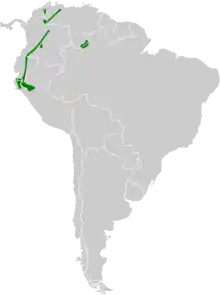Grey-chinned hermit
The grey-chinned hermit (Phaethornis griseogularis) is a species of hummingbird in the family Trochilidae. It is found in Colombia, Ecuador, Peru, Venezuela, and - marginally - far northern Brazil. Its natural habitats are subtropical or tropical dry forest, subtropical or tropical moist montane forest, and heavily degraded former forest. This is not a quiet species, where it will often sing and have audible wing noises.[2]
| Grey-chinned hermit | |
|---|---|
 | |
| Scientific classification | |
| Kingdom: | Animalia |
| Phylum: | Chordata |
| Class: | Aves |
| Order: | Apodiformes |
| Family: | Trochilidae |
| Genus: | Phaethornis |
| Species: | P. griseogularis |
| Binomial name | |
| Phaethornis griseogularis Gould, 1851 | |
 | |
| Synonyms | |
| |
They tend to sing the most in early mornings and afternoons - with males singing a 'warbling' tune described as a "tzz, weeh-weeh-tzee-dee" with their bills upright and open and wagging their tails.[3] Often forming leks, these males will distribute themselves in a way to make sure they can hear the other males, but not see them.[3] They defend these territories that they keep.[3]
They feed via traplining and have a diet consisting of arthropods and nectar.[4]
Subspecies[4]
- P. g. griseogularis Gould, 1851 – W of Andes in Colombia; E Andes from Colombia S to N Peru (San Martín); S & SE Venezuela and adjacent N Brazil (on several isolated mountains).
- P. g. zonura Gould, 1860 – N Peru (Marañón Valley in E Cajamarca and adjacent Amazonas).
References
- BirdLife International (2012). "Phaethornis griseogularis". IUCN Red List of Threatened Species. 2012. Retrieved 26 November 2013.CS1 maint: ref=harv (link)
- "Gray-chinned Hermit - Introduction | Neotropical Birds Online". neotropical.birds.cornell.edu. Retrieved 2019-05-29.
- Schuchmann, Karl-L. (1987). "First Record of the Grey-Chinned Hermit (Phaethornis griseogularis) West of the Colombian Andes, with Notes on the Displays of the Species". The Wilson Bulletin. 99 (1): 122–124. ISSN 0043-5643. JSTOR 4162356.
- "Grey-chinned Hermit (Phaethornis griseogularis)". www.hbw.com. Retrieved 2019-05-29.
